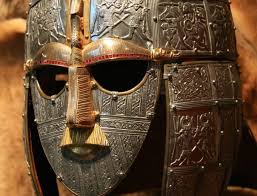
Let's let Professor Tolkien demonstrate.
Take a word from Old English—English as it was spoken 1000 years ago—one that either never existed, or once existed, but didn't survive into modern times: say hol-bytla, “hole-builder.”
Ask yourself: if this word had survived into modern times, and undergone—mutatis mutandis—all the usual sound changes, what would it look like today?
Enter hobbit.
If there is a linguistic term for this process of artificial verbal aging, I for one don't know what it is. Over the years, drawing on the Greek and Latin vocabulary that linguists tend to use to describe matters linguistic, I've coined several names for the process. None were sufficiently utile (or beautiful) to linger even in the memory of the coiner.
(Yes, I could laboriously go back through my notebooks and find them again. I'll spare both you and me the results.)
Recently I asked fellow ledesman (see below) Theodsman Nick Ritter—a better linguist than me, any day of the lunar month—what he would call it.
Anglishing, he promptly fired back.
Anglish is the name given to the conlang (“constructed language”) which asks precisely this question: if the English language had never undergone the type of linguistic imperialism that overtook it after 1066, what would it look like today?
One of the foundational principles of Anglish is the avoidance of Romance/Classical vocabulary whenever possible. Hence, my abortive attempts to coin a Greco-Latin term for this process of linguistic updating, wrong-headed from the beginning.
Thanks, Nick: Anglishing it is.
(“How, then, would one Anglish 'Beowulf'?” I ask him.
Beowulf's people, the Geats, also fell out of memory, as did the hero—whose name means “bee-wolf” (i.e. bear) himself. But Nick, of course, has a ready answer.
Hail and welcome, Bolf the Yeet.)
Old English had two different words that could be translated “tribe” or “people”: théod and léod. Without a detailed study of the words in their original context, it's hard to say what the difference in denotation between the two might have been to the English-speaking ancestors.
With the demise of tribal identity among speakers of English, neither of these words survived into modern times—13th century scholars had to borrow the Latin word for the concept—but, via the wonders of Anglishing, we can say that, had they survived, we would today say thede and lede.
So, what's the difference these days? Easily told: the people writ small, and the people writ large.
Example #1: While regarding themselves primarily as Athenians, Spartans, or Corinthians, ancient Greeks would all have regarded themselves as Hellenes.
Example #2: Speakers of Anishinabe (“Ojibway”) share a larger sense of kinship with other speakers of Algonquin languages, the larger linguistic family that includes Anishinabe and various other related languages.
Example #3: Modern-day Wiccans: Witch by thede, Pagan by lede.
Lest anyone think such linguistic nativism unique to speakers of English, let me hasten to assure you that there's an entire movement out there to revive Gaulish, the extinct language of ancient Gaul.























